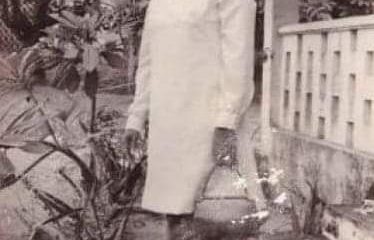Features
Kano Rainfall Anomaly: An indicator of climate change
Features
Kano Women Battle for Bed Spaces at Major Hospitals, Leaving Many Stranded or Worse – Dead
Aisha Ahmad Ismail
It was a dark day for Malama Khadija, who despite heavy bleeding with no pads on has been on the road for almost 8 hours, seeking help for a baby that has not cried a day after birth even after visiting 9 hospitals in Kano.
The new mother was forced to ride in her husband’s tricycle, ignoring the dripping blood as they went to 9 hospitals, none accepted them for mainly reasons of bed space
Khadija birthed a girl on Monday, when health care workers at asibitin Bela noticed the child did not cry, and later referred them to Hasiya Bayero Pediatric Hospital for better access to professionals.
Here, a security guard asked them to ‘not waste their time’ as they do not care for children who did not cry at birth.
Other hospitals, the new parents visited Murtala Muhammad specialist where the father said the child was first checked, and her legs pinched with ‘something’.
They were later asked to leave for lack of bed space, and referred to another hospital.
The worried mother held the little girl now named Aminatu as they headed to Muhammad Abdullahi Wase Teaching Hospital. There, the doctors refused to attend to the child because they were on strike.
Malam Bala, the new father and a tricycle rider told this reporter that a police officer threatened to shoot a doctor for delayed attendance to his daughter born with similar condition to his. Doctors asked them to leave.
The brave new parents jostled the new born to another pediatric hospital; Sheikh Khalifa Isyaku Rabiu Pediatrics Hospital along Zoo Road, and their hopes were raised when a doctor started checking on her. A few minutes later, she came up with the same answer as the specialist hospital – no bed space.
Again, they left for Aminu Kano Teaching hospital with the help of a philanthropist they met on their long, hope dashing journey, Hajiya Binta and like before, there was no available bed space.
The parents, exhausted but not giving up on their child, went to a private health facility, where a bed space costs N10,000 per night, something the father said he could not afford if not for the charitable efforts of Hajiya Binta.
With her help, they paid for file N5,000, tests to be run on little Aminatu N6,000, drugs cost N15,000 and an injection N4,000.
He said they were able to spend just one night, as the expenses were much and he had to owe the hospital N21, 000.
Little Aminatu did not cry 7 days after her birth at which was the time of filing this report, and her parents are at home hoping one day, she would cry or stay quiet forever.
Khadija’s case is amongst the many maternal health related complications in the state; in Sept. 2022, a lady, Zainab lost her child and her life at Murtala Muhammad Specialist hospital; in February 2023, a woman now late Hajiya Shema’u Sani Labaran bled to death due to lack of cash at hand for treatments.
In 2024, an investigation by Solace base led to a whole community of women at Mazan Gudu community, Gabasawa LGA who survive pregnancy and childbirth on luck.
These are not isolated cases; but few of the many increasing preventable deaths at childbirth. According to UNICEF in 2018, Nigeria contributes 14% of global maternal deaths. The global body says at least 262, 000 babies die at birth, as the infant mortality rate stands at 69% per 1,000 births.
According to the National Health Care Development Agency 145 women die daily at childbirth in the country, with the highest figures coming from Northern Nigeria.
The staggering figures of maternal mortality and morbidity must have alarmed the Kano state government, leading to finding ways to ease the burden, amongst which is the creation of the Kano State Health Trust Fund created in 2017.
Women Die at Birth Despite Government’s Claimed Enhanced Funding
“I just returned from the burial of a woman who died from childbirth complications, the child is alive and hearty.”
This is the response of the Ja’en ward head, located at Sharada, Gwale LG, Isma’il Sa’ad Usman to the question of maternal mortality and morbidity is his domain.
He said he is not entirely sure why, but despite government’s interventions and NGOs, maternal deaths are not uncommon in many areas in Kano, including his.
Our trip to the primary health care in the area was really short, as health officers were ‘afraid’ of the media.
The Ja’en PHC was bustling with women hoping to get ante-natal care
However, one officer who spoke briefly said women at the local level are wising up to accessing health facilities like theirs, adding that the state has trained officers enabling them to quickly refer to complicated births to higher facilities.
Interviews at some primary health care facilities reveal reduced death rates at the facilities.
A tour of Gwagwarwa primary health care showed women showing up for antenatal as health personnel move around to cater for their needs.
A health personnel at the facility who spoke on anonymously said though there are deaths at childbirth or after due to complications, they mostly occur at secondary and tertiary institutions or at home.
Women attending ante natal at Gwagwarwa PHC
The health officer revealed that whenever a complication arises from birth, they are quick to refer to more qualified facilities, but lack of bed spaces of money for basic things make the patients return home, only to later die from preventable health complications.
According to the source, they have heard stories of deaths of either mother and child, or one of the two afterwards.
The village head of Gama, Malam Rabi’u Muhd Isyaku said people are poor, and have resorted to seeking help from Friday mosques or radio stations to treat maternal health problems.
He said there are reports of maternal mortality, but it hardly goes public as they are mostly recorded at home.
“I am always heart broken when I hear a plea for help to cater for a pregnant woman during or after birth,” he added.
Nurse Laments Maternal Mortality; Blames Shortage of Staff .
Nurse Maimuna works at one of the government hospitals in Kano, she said they have recorded deaths at different stages of childbirth.
She said they have recorded deaths due to obstructed labor and prolonged labor that comes late to the hospital.
The nurse added that some women labor (active labor) for 20-30 hours, contrary to the ‘normal’ hours, leading to eventual deaths of both mother and child, or just the child.
Nurse Maimuna lamented how they are overwhelmed with patients that they skip women who are in need in urgent help or C-section.
She has witnessed few women die due to work overload that distracts health personnel at tertiary some institutions.
KHETFUND: Improved Maternal Health Care Promises Fulfilled?
In 2017, the Kano government led by former Governor Abdullahi Umar Ganduje championed the State Trust Fund to help augment the state budget on health, including maternal and newborn health.
Speaking with this reporter, the former state health commissioner, Dr. Aminu Ibrahim Tsanyawa said the law mandates 5% of the fund’s money to the health sector.
He said from the time of Governors Rabi’u Musa Kwankwaso to Malam Ibrahim Shekarau and Abdullahi Ganduje, there has been a free birth and post birth policy which all governments sustained irrespective of political ideologies.
Former health commissioner Kano, Dr. Aminu Ibrahim Tsanyawa
However, there are times when the budget funds are not released on time, or the government is starved of cash, thus the 5% of the fund to ensure the maternal and childbirth ‘always’ gets the necessary attention and funds.
.
Also speaking with this reporter, the director operations, KHETFUND, Dr. Muhamad Lawan Adamu said the 5% for maternal and children is on standing order and has never been delayed, unlike funds meant for hospitals- from primary to tertiary, institutions and others.
According to him, the 5% is handed over to the Kano Hospitals Management Board monthly.
According to another official of KHETFUND, Hamisu Abubakar who is the director admin and services, there has been constant cash flow into the fund from the mandatory 5% monthly IGR and 1% from LGAs allocation since the inception of the current Abba Kabir Yusuf administration, signaling that the fund is not starved of funds.
.
KHETFUND Budget Performance
The Kano State Health Care Fund mandates that 50% of the budget be allocated to hospital (Pri, Secondary and Tertiary), 25% to health education institutions 2% to running of the fund, 2% to the vulnerable groups, 5% to maternal health care.
Kano budget performance shows low performance of the KHETFUND; however, this does not affect the 5% maternal health care fund as confirmed by officials of KHETFUND.
The 1st quarter of 2024 budget shows 0% performance of the budget despite the allocation of N800,000,000 to the fund as shown on page 7.
With a budget of N1,200,000,000 in 2023, the fund recorded only 2.1% budget performance, also as seen on page 7 of the document.
With a budget of N1,400,000,000 in 2022, KHETFUND had a 5% budget performance as seen on page 6 of the budget performance document.
YEAR
AMOUNT
PERFORMANCE %
2024
N800m
0%
2023
N1.2bn
2.1%
2022
N1.4bn
5%
Source: Kano budget performance documents
The low performance, according to a KHETFUND official, is not unconnected to the fact that hospitals and institutions do not write to the fund requesting for their needs.
Dr. Muhamad Lawan Adamu, director operations of the fund said they disburse funds only when requested and after due process – with the exception of the maternal health 5% of course.
Despite 5% KHETFUND Maternal Allocation, Why Maternal Health Crisis?
A trip to the Kano Hospital Management Board as directed by the Kano State Health Ministry through the spokesperson, Ibrahim Abdullahi led me to the office of the officer in charge KHETFUND at the board.
He however refused to speak for ‘lack of authorization’ to speak with the media on the issue.
Another trip to the board revealed that the 5% fund from KHETFUND was received regularly. Speaking anonymously, an official said there are many factors for persistent problems with maternal health in Kano.
The first issue the official raised was that the fund was only meant to ‘augment’ needs in the sector, and this will be based on request.
The second problem the official noted was lack of enough doctors/health personnel to man any additional bed or space at the hospitals thus the fund was used to purchase drugs and all other valuables/instruments, including for CS to care for pregnant women and the babies.
NGOs Worry Over Shortage of Bedspaces, underutilization of PHCs
Sanusi Hashim, is the contact person for Society for Child Support and Economic Empowerment, he said they are worried by widely reported maternal deaths despite increased funding and positive government policies.
According to him, many factors are responsible for the trend including
Under utilization of PHCs; According to the officer, they have come to understand that most pregant women would rather go to the ‘bigger’ hospitals that the Primary Health Cares within their locality. Though some PHCs are in terrible conditions, many have been improved to even carry out Cesarean Sections should the need arise. He said these could have eased pressure on the secondary and tertiary health facilities in the state, reduce mortality rate further and provide adequate health care to both mother and child – free of charge.
Lack of bed spaces: Due to the inflow of patients from all 44 LGAs in Kano, Mr. Hashim Sa’id there is congestion and lack of space. He revealed that a tour to one of the tertiary hospitals; Abdullahi Wase Teaching Hospital showed no bed space available to cater for more patients. This he said.
NGO Provides Additional Solutions to Maternal Mortality and Morbidity
Society for Child Support and Economic Empowerment said there is urgent need for government to equip, upgrade and provide adequate personnel at ‘all’ primary health care centers in the state.
The contact person, of the organization, Sanusi Hashim says this will take excellent health care to the doorstep of the masses in all LGA, thus reduce pressure on the secondary and tertiary institutions.
After that, he advocates for intensive campaign on the importance and need for pregnant women to patronize PHCs in their areas.
Sanusi also called on the Kano State Government to increase wards and bed spaces at all health facilities.
On their parts, traditional leaders at Sharada Ja’en and Gwagwarwa seek increased funding and special packages for the poor in the society.
Features
How Maryam Abacha Varsity Produced 5 Provosts of Nursing Colleges, 1,000 Lab Scientists, 100 Lawyers, Others in 12 Years
Twelve years after its establishment, the Maryam Abacha American University of Niger (MAAUN), in Maradi, Niger Republic, has produced five Provosts of Nursing Colleges in Borno, Yobe, and Bauchi States.
Dr. Hadiza Sabo a graduate of Nursing from the University is the current Provost of Shehu Sule College of Nursing and Midwifery, in Damaturu, Yobe state.
Varsity Appoints Gombe Emir As Chancellor
Equally, Dr. Hadiza Yahya is serving as Provost, College of Nursing Sciences in Maiduguri, Borno state, while Dr. Rakiya Saleh is the Provost College of Nursing Sciences in Bauchi, Bauchi state. The trio of Rakiya and the two aforementioned Hadizas all bagged their first and postgraduate degrees from MAAUN.
In addition, Kiloh Nifor who is also the Provost, College of Nursing Sciences in Jalingo, Taraba state, and Dr. Yusuf Bello, the Provost, Kaduna State College of Nursing Sciences, are also alumni of the university.
MAAUN, which was founded in 2013, is owned by Professor Adamu Abubakar Gwarzo, a philanthropist and French Linguistics scholar.
Politics Digest also reports that the Faculty of Law of the premier Ivory Tower, established only in 2015, has produced over 400 law graduates, with more than a hundred of them already called to the Nigerian Bar.
In addition, over 1,000 Medical Laboratory Scientists produced by MAAUN are presently working in Nigeria, while no fewer than 700 of them are practicing abroad.
It would be recalled that the institution was the first to offer a Bachelor of Science degree in Nursing in Niger Republic, where thousands of nursing officers trooped for their university education from different countries.
“The Nursing Degree programme greatly increased the number of nursing graduates in Nigeria. The university started offering Nursing in 2012 and has so far graduated over 2,000 graduates who are rendering their services at different hospitals in Nigeria and abroad,” said the university’s President, Prof. Adamu Abubakar Gwarzo.
Barrister Umar Isa Sulaiman, a law lecturer at MAAUN, while informing Politics Digest that their Faculty commenced academic activities in 2013, said: “Our graduates are working in different government agencies and parastatals. Some are Sharia Court Judges, Magistrates, and some are working in the Supreme Court of Nigeria.
“Also, a high number of our graduates are in private practice. We do meet and appear before different courts. I can categorically tell you that they are doing wonderfully well as advocates.”
Furthermore, the Prof. Adamu Gwarzo-owned university has been positively impacting the lives of several Nigerians.
A MAAUN graduate of Nursing, Hamisu Iliyasu, who hailed from Sokoto State, told this newspaper how his alma mater produced many Directors and Heads of Nursing Colleges in Nigeria.
“You know universities in the North don’t offer Nursing; you either go to the South or you end up retiring at Level 14 as a civil servant. But our prestigious Maryam Abacha American University came to the rescue of so many of us, and we are grateful,” he said.
According to Dr. Kabiru Mahmud, a staff member of the Medical Laboratory Sciences Department of MAAUN, “Our great and pace-setting university has helped increase the number of Medical Laboratory Scientists, not only in Northern Nigeria but in the country at large. We have students from across the country.
“Some came from Lagos, Benin, and Ibadan. I can categorically tell you that Maryam Abacha American University of Niger has the highest number of young Medical Laboratory Scientists in Nigeria.
“Before now, one could hardly find someone with a degree in this field, but only a Diploma. But MAAUN came and provided the opportunity to many undergraduates. Go to Federal Medical Centres across the country, and you will find it difficult counting the number of their staff who are our products.”
Checks by this newspaper further revealed that some MAAUN alumni are presently working at the National Hospital in Abuja and the Mallam Aminu Kano Teaching Hospital, AKTH, in Kano state.
The university according to findings has the highest number of Nurses working in Canada, USA and other foreign countries from West Africa.
Features
Hotoro Residents Threaten to Vote Out Leaders in 2027 Over Dilapidated Road
Residents of Hotoro in Kano State are voicing their growing frustration with local and state leaders over the deplorable condition of a key road in their community. In interviews with Nigerian Tracker, the residents expressed deep dissatisfaction and issued a warning that they may withhold their votes in the 2027 elections if their concerns continue to be ignored.
Shehu Usman, a long-time resident of Hotoro, articulated the sentiments of many in the area. “Our area is a vote bank, not just in Nassarawa Local Government but across the whole of Kano State,” Usman said. “Yet, the road is no longer passable in both the rainy and dry seasons, and those we elected—from the Governor to the Chairman and even the legislators—seem not to care about the deplorable state of this road.
The road in question, which remains untarred, stretches from the Ring Road around Nur Petroleum Junction, passes through Hotoro Primary and Secondary Schools, and ends at the Hotoro Police Division. The poor state of the road has been a long-standing issue, but despite repeated complaints, nothing has been done to address it.
Iliya Musa, another concerned resident, lamented that politicians only seem to care about the community during election season. “During election season, politicians flock to our area, making promises and shaking hands. But once they are in office, they turn a deaf ear to our problems,” Musa said. “This road could easily be constructed, but our leaders have ignored us, and now, it feels like the area is turning into a slum.”
As 2027 approaches, the residents of Hotoro are making it clear that their votes will not be taken for granted. If their elected leaders fail to address the worsening conditions in the community, they may face a harsh electoral backlash from a constituency that has had enough of broken promises.
-

 Opinion3 years ago
Opinion3 years agoOn The Kano Flyovers And Public Perception
-

 Features3 years ago
Features3 years agoHow I Became A Multimillionaire In Nigeria – Hadiza Gabon
-

 History4 years ago
History4 years agoSheikh Adam Abdullahi Al-Ilory (1917-1992):Nigeria’s Islamic Scholar Who Wrote Over 100 Books And Journals
-

 Opinion4 years ago
Opinion4 years agoKano As future Headquarters Of Poverty In Nigeria
-

 History4 years ago
History4 years agoThe Origin Of “Mammy Market” In Army Barracks (Mammy Ochefu)
-

 News3 years ago
News3 years agoFederal University Of Technology Babura To Commence Academic Activities September
-

 Opinion3 years ago
Opinion3 years agoMy First Encounter with Nasiru Gawuna, the Humble Deputy Governor
-

 Opinion4 years ago
Opinion4 years agoKhalifa Muhammadu Sanusi II, A Phoenix Rises